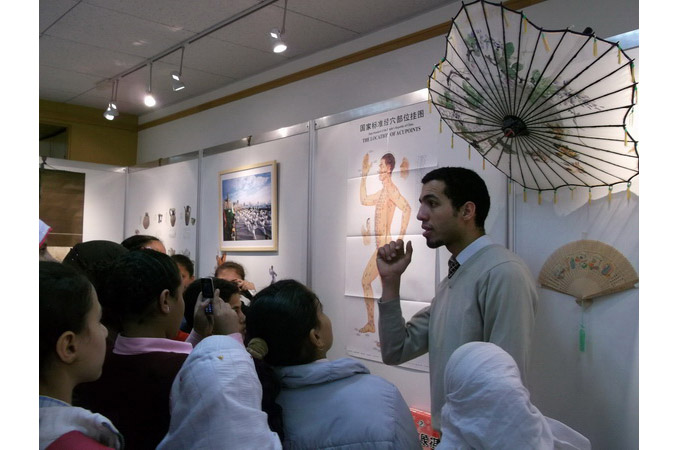
Middle school students visit the China Culture Center in Cairo to gain knowledge of Chinese traditional medicine.[Photo provided to China Daily]
China will hasten the process of building cultural centers in countries along the ancient Silk Road as part of an expansion plan for such institutes. The central government is looking to have at least 50 such centers by 2020, up from the current 20, officials from the Chinese Ministry of Culture said during a recent Chinese New Year celebration in Istanbul.
In Sri Lanka and Nepal, which are included in China’s “Belt and Road” initiative, China has already built two culture centers that will open soon, Yu Jian, director for the Division of Western Asia and Northern Africa Affairs at the Ministry of Culture, said at the Feb 14 event. He added that China and Turkey are prepared to have the China Culture Center in that country soon.
Under the “Belt and Road” initiative, more highways, railways and air routes will be established, and Chinese regions will further integrate resources, policies and markets to connect with the outside world, according to Xinhua News Agency.
As a link for transportation between the West and the East, Turkey played a key role on the ancient Silk Road.
“We hope Turkey’s China culture center will be a landmark building. The center should attract as many young people as possible and maintain close cooperation with local communities,” Yu says.
Xiang Zhaolun, China’s deputy minister of culture, was also present at the Istanbul gala that was held to promote the Spring Festival.
The nations that share good relations and have close cultural exchanges with China will be among the top places where the centers will come up, according to Yu.
On Feb 11, Yan Dongsheng, deputy director of the Ministry of Culture’s finance division, said that for setting up cultural centers overseas, China had invested about 1.33 billion yuan ($214 million) by the end of 2014. This year, the budget for developing and running the institutes abroad is 360 million yuan, up 181 percent compared to last year.
China set up its first culture centers in Mauritius and the Republic of Benin in 1988. From 2002, it opened more, in Cairo, Paris, Malta, Berlin and Tokyo.
They are “windows” to showcase Chinese culture, Yan said.
Yu said that Chinese high-tech companies will also join the campaign to promote China’s technological innovations in the overseas markets.
In Cairo, the center that was built in 2002 has been a good platform for locals to know China and learn about Chinese art, music, dance, cuisines and languages, says Chen Dongyun, director of the Cairo center.
Standing next to the pyramids, the five-story Cairo center has trained more than 8,000 Egyptians in Chinese languages and martial arts. In addition, it offers regular classes on Chinese cooking and kite-making.
Chinese movie weeks and exhibitions of traditional arts such as calligraphy are also available.
Chen, the director, says that the number of the center’s followers on Facebook reached 10,000 in less than a year. More than 11,000 attended a Happy Spring Festival activity held by the center at a Cairo park, double the number of visitors to the same event last year.
Unlike the Confucius Institutes that mainly focus on teaching Chinese language, China’s culture centers lean more toward promoting culture and showing the lives of ordinary Chinese, says Chen.
